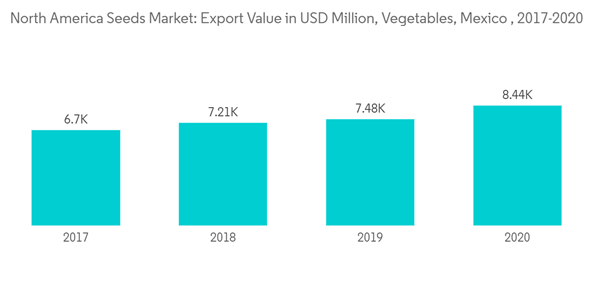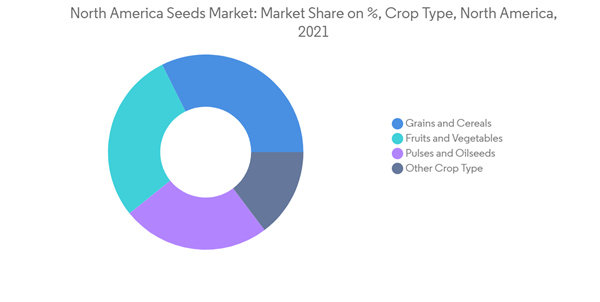The North American seeds market is projected to register a CAGR of 7.0% for the forecast period (2022 - 2027). Farm production all over North America has been affected by bottlenecks for inputs, most notably labor. Restrictions on the mobility of people have reduced the availability of seasonal workers for planting and harvesting in the fruit and vegetable sector in many countries. The COVID-19 pandemic has had a disruptive impact on the North American seed sector due to the shortage of seasonal workers. The shortage of labor, coupled with the unfavorable weather conditions, augmented the decline in demand for seeds.
The major factors driving the industry include the rising demand for animal feed, increasing usage of biofuels, growing demand for grains, oil, and vegetables, and rapid adoption of biotech crops. The US seed market changed dramatically over the past century as more farmers purchased commercial seeds. The hybrid seeds of tomato, lettuce, and sweet pepper are the highest in demand. Broccoli and spinach are highly concentrated in California. A large portion of the vegetable-growing community in the country prefers hybrid, high-yielding, and disease-resistant varieties of vegetables.
Many firms also license or outsource marketing and distribution to private firms and individuals in order to improve access to the local markets. Some of the key players in the market include Syngenta US, Groupe Limagrain Holding, BASF SE, DuPont (Pioneer), and Rijk Zwaan.
The production of cereals, fruits, and vegetables in North America is increasing gradually. The growing export potential of cereals, fruits, and vegetables has put pressure upon the farmers in North America to produce more to meet domestic as well as international demand. This has further resulted in the need for quality crop seeds to enhance the yield and productivity while the decrease in the arable land. Regarding the rising export potential of agriculture produce in North America, various players in the market are developing different seeds that are disease resistant. According to the ITC trade map, the vegetable export in Mexico increased by 11.87%, from USD 6,697,858 thousand in 2017 to USD 8,444,312 thousand in 2020. A large portion of the vegetable-growing community in countries like Canada, Mexico, United States prefers hybrid, high-yielding, and disease-resistant varieties of vegetables. The rising export potential for cereals, fruits, and vegetables has resulted in higher production of these crops, thereby rising demand for quality seeds by farmers that are pest- and disease-resistant and are tolerant to adverse climatic conditions for enhanced yield.
In Canada, farmers mostly grow potatoes, tomatoes, lettuce, onion, carrot, sweet corn, cucumber, and cabbage. In the United States, the hybrid seeds of tomato, lettuce, and sweet pepper are the highest in demand. California, North Dakota, Idaho, Michigan, Minnesota, Washington, and Wisconsin are the major vegetable seed markets in this region. Broccoli and spinach are highly concentrated in California.
Mexico is the country where most vegetables are grown in protected cultivation in greenhouses. It is the second-largest vegetable-growing country in North America. The seed market in Mexico is dominated by saved seeds, while the import of quality seeds is rising. Individual farmers, large multinational companies, national private seed companies, national public research, and seed production organizations, such as INIFAP and international agricultural research centers, constitute the Mexican seed industry. Mexico has 50,000-acre land under vegetable cultivation, and almost 60% of the area is occupied by vegetable cultivation in greenhouses. The production of vegetables is constantly increasing in North America, as the demand is increasing.
The industry is highly concentrated, and the most innovative companies are well-positioned in the market. Syngenta and DuPont, BASF SE, Rijk Zwaan, Groupe Limagrain Holding, and Bayer CropScience are the companies dominating the market.
This product will be delivered within 2 business days.
The major factors driving the industry include the rising demand for animal feed, increasing usage of biofuels, growing demand for grains, oil, and vegetables, and rapid adoption of biotech crops. The US seed market changed dramatically over the past century as more farmers purchased commercial seeds. The hybrid seeds of tomato, lettuce, and sweet pepper are the highest in demand. Broccoli and spinach are highly concentrated in California. A large portion of the vegetable-growing community in the country prefers hybrid, high-yielding, and disease-resistant varieties of vegetables.
Many firms also license or outsource marketing and distribution to private firms and individuals in order to improve access to the local markets. Some of the key players in the market include Syngenta US, Groupe Limagrain Holding, BASF SE, DuPont (Pioneer), and Rijk Zwaan.
Key Market Trends
Increased Demand from the International Market
The production of cereals, fruits, and vegetables in North America is increasing gradually. The growing export potential of cereals, fruits, and vegetables has put pressure upon the farmers in North America to produce more to meet domestic as well as international demand. This has further resulted in the need for quality crop seeds to enhance the yield and productivity while the decrease in the arable land. Regarding the rising export potential of agriculture produce in North America, various players in the market are developing different seeds that are disease resistant. According to the ITC trade map, the vegetable export in Mexico increased by 11.87%, from USD 6,697,858 thousand in 2017 to USD 8,444,312 thousand in 2020. A large portion of the vegetable-growing community in countries like Canada, Mexico, United States prefers hybrid, high-yielding, and disease-resistant varieties of vegetables. The rising export potential for cereals, fruits, and vegetables has resulted in higher production of these crops, thereby rising demand for quality seeds by farmers that are pest- and disease-resistant and are tolerant to adverse climatic conditions for enhanced yield.
Fruits and Vegetable Segment Dominates the Market
In Canada, farmers mostly grow potatoes, tomatoes, lettuce, onion, carrot, sweet corn, cucumber, and cabbage. In the United States, the hybrid seeds of tomato, lettuce, and sweet pepper are the highest in demand. California, North Dakota, Idaho, Michigan, Minnesota, Washington, and Wisconsin are the major vegetable seed markets in this region. Broccoli and spinach are highly concentrated in California.
Mexico is the country where most vegetables are grown in protected cultivation in greenhouses. It is the second-largest vegetable-growing country in North America. The seed market in Mexico is dominated by saved seeds, while the import of quality seeds is rising. Individual farmers, large multinational companies, national private seed companies, national public research, and seed production organizations, such as INIFAP and international agricultural research centers, constitute the Mexican seed industry. Mexico has 50,000-acre land under vegetable cultivation, and almost 60% of the area is occupied by vegetable cultivation in greenhouses. The production of vegetables is constantly increasing in North America, as the demand is increasing.
Competitive Landscape
The industry is highly concentrated, and the most innovative companies are well-positioned in the market. Syngenta and DuPont, BASF SE, Rijk Zwaan, Groupe Limagrain Holding, and Bayer CropScience are the companies dominating the market.
Additional Benefits:
- The market estimate (ME) sheet in Excel format
- 3 months of analyst support
This product will be delivered within 2 business days.
Table of Contents
1 INTRODUCTION
4 MARKET DYNAMICS
5 MARKET SEGMENTATION
6 COMPETITIVE LANDSCAPE
Companies Mentioned (Partial List)
A selection of companies mentioned in this report includes, but is not limited to:
- Monsanto Company
- Syngenta US
- Groupe Limagrain Holding
- DuPont Pioneer
- KWS SAAT SE & Co.
- DLF-Trifolium
- Sakata EMEA
- Takii Europe B.V.
Methodology

LOADING...










